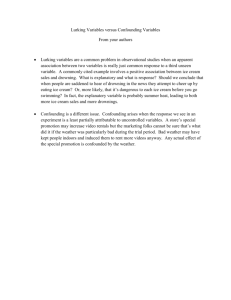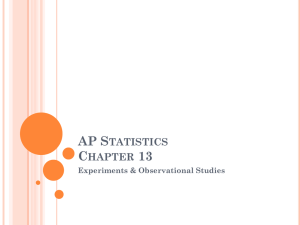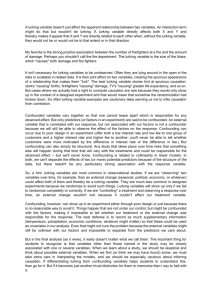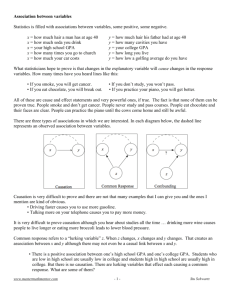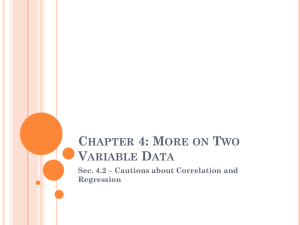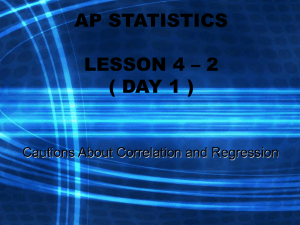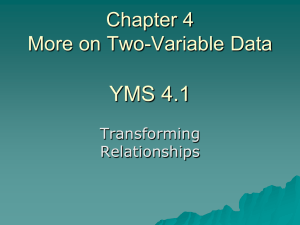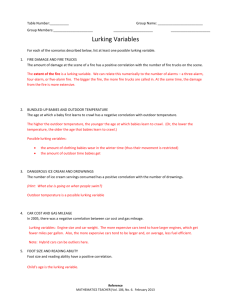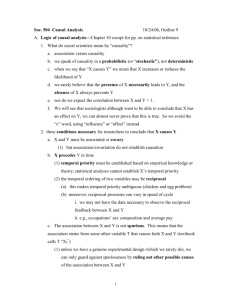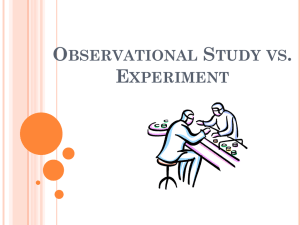390_2_CauseandEffect
advertisement
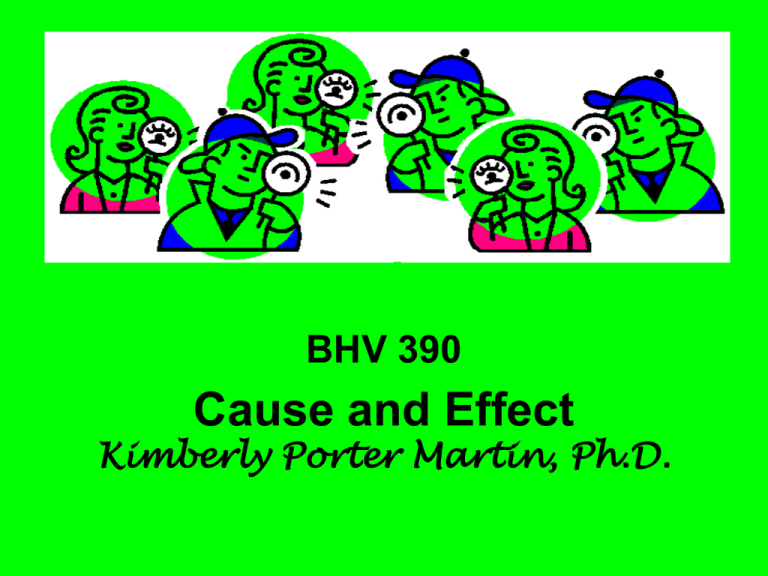
BHV 390 Cause and Effect Kimberly Porter Martin, Ph.D. Requirements for Cause and Effect 1. The causal variable and the effect variable must be consistently, but not necessarily always associated with one another. 2. The causal variable must ALWAYS preceed the effect variable in time. 3. All confounding/lurking variables that might confuse the relationship between cause and effect must be eliminated. 1. Consistent Association of Cause and Effect Variables If one thing causes another, then there should be a strong association (in statistical terms, a strong correlation) between the two. Eg. Striking a match and fire. Striking a match always causes a fire, at least at the tip of the match. But fires are not always caused by matches, so the correlation/association will not be perfect, that is, fire will not always be associated with striking a match. 2. The Cause Must Always Preceed the Effect For something to be the cause, it logically must preceed the thing it is causing. For one thing to flow from another, the producer that must exist before the product. This flows from basic logic. Eg. For a fire to be produced from the striking of a match, the match must exist and be struck before the fire can be produced. If the fire comes before the match is struck, then logic dictates that the fire cannot have been caused by the striking of the match. 3. All Confounding or Lurking Variables Must Be Eliminated It is possible for two things to be consistently associated with one another, and both be caused by a third variable. This third variable is called a “confounding” or “lurking” variable. Eg. It is a statistical fact that the number of drowning deaths and the amount of ice cream sold in beach communities are highly correlated (associated) with one another. Drowning deaths do not cause ice cream sales, and ice cream sales do not cause drowning deaths. Both are caused by hot weather/the summer season. 3. All Confounding or Lurking Variables Must Be Eliminated (con’t) Eg. It is a statistical fact that the amount of alcohol sold is highly correlated (associated) with the salaries of teachers. This means that as teacher’s salaries go up, so do alcohol sales, OR as alcohol sales go up, so do teacher’s salaries. Neither of these variables is causing a change in the other. Instead, a third variable, the state of the general economy is causing changes in both. As the economy improves, teachers are paid more, and people have more income to spend on alcohol. Important! It is rare that social research can demonstrate clear and unambiguous causal relationships between two variables. Usually, social research can only demonstrate associations/correlations between variables, because it is hard to show which variable came first, and to eliminate ALL confounding/lurking variables. The exception are demographic variables such as age, gender and ethnicity. It would be logically silly to say that income would cause a difference in gender. Therefore we can assume that a difference in income is caused by gender. Experiments and Causality • Experiments are considered the best method for attempting to demonstrate causality. 1. They show that a change in the dependent variable (DV) is consistently associated with the independent variable (IV). 2. The procedures insure that the IV always comes before any change in the DV. 3. The experimental process is designed to control/eliminate as many lurking variables as possible, and only allow the IV to be a causal factor Conclusions • Researchers using any method other than experiments should be very careful about claiming that they have demonstrated that one thing causes another. • A STATISTICAL RELATIONSHIP LIKE A CORRELATION DOES NOT MEAN THAT ONE THING CAUSES ANOTHER! Powerpoint Study Guide • • • • • Cause Variable Effect Variable Lurking Variable Time Sequence Association
